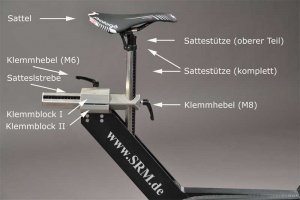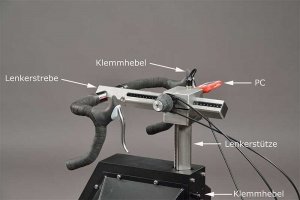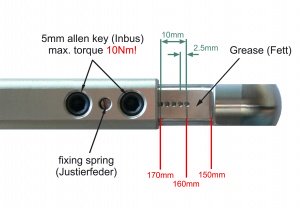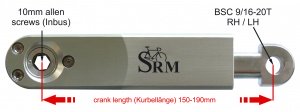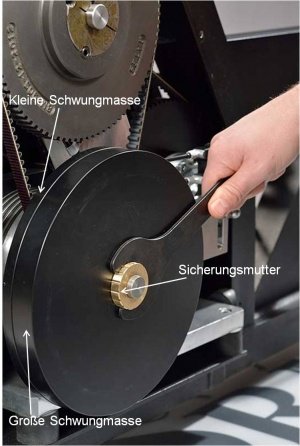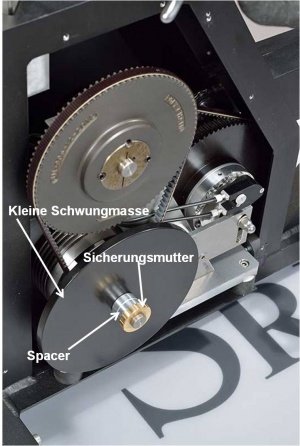Difference between revisions of "Mechanical Fundamentals"
| Line 12: | Line 12: | ||
File:Verlängerbare_Kurbel_1.jpg|Prolongable Crank 1 | File:Verlängerbare_Kurbel_1.jpg|Prolongable Crank 1 | ||
File:Verlängerbare_Kurbel_2.jpg|Prolongable Crank 2 | File:Verlängerbare_Kurbel_2.jpg|Prolongable Crank 2 | ||
| − | File:022-Montage-Schwungmassen.jpg|Change of the | + | File:022-Montage-Schwungmassen.jpg|Change of the flyingwheels |
File:021-Getriebe-Schwungmassen.jpg|Illustration with smaller flywheel and corresponding spacers | File:021-Getriebe-Schwungmassen.jpg|Illustration with smaller flywheel and corresponding spacers | ||
</gallery> | </gallery> | ||
| Line 67: | Line 67: | ||
</gallery> | </gallery> | ||
| − | The kinetic energy of the cyclist equals the rotational energy of the | + | The kinetic energy of the cyclist equals the rotational energy of the flywheels. |
The kinetic energy of the cyclist is: E = v² x m/2 | The kinetic energy of the cyclist is: E = v² x m/2 | ||
Revision as of 18:10, 22 January 2014
|
Languages |
|---|
The mechanical adjustment of the SRM – Ergometer allows the rider to find his individual positioning.
Positioning of the athlete
Before every performance diagnostic you have to check the positioning of the athlete.
Optimizing individual positioning is quickly achieved by adjusting the saddle and handlebar vertically and/or horizontally. To do so you have to open the locking lever. Because of a ruler which is attached to the saddle post you can reproduce your perfect positioning.
If adjusted correctly, it should be easy to move the vertical and horizontal stems when the quick release is open. A 5 mm Allen key situated on the saddle and handlebar mounts allows for further rigidity.
- Horizontal Positioning of the saddle
- The ruler which is integrated in the seat stay gives you the distance between the center of the bottom bracket and the front of the saddle. The distance in cm can be read from the left hand side of the seat stay.
- Sobald die Position des Sattels auf der Sattelstütze verändert wird passen allerdings die Abstände mit den den eingeklebeten Linealen nicht mehr überein. Dann müssen die Abstände auf den Linealen manuell korrigiert werden oder evtl. neue Lineale eingeklebt werden.
- Vertical Positioning of the saddle
- Horizontal Positioning of the handlebars
- Vertical Positioning of the handlebars
- Prolongable Crank
- The prolongable crank has round markings every 2.5 mm and every 10 mm a line. If the steel element of the crank is completely retracted in the aluminium crank the minimal length of the crank arm is 150 mm. If the crank arm is completely pulled out, the maximal length is 190 mm. Before changing the crank arm length you have to open both Allen screws.
- After adjusting the right crank arm length, please tighten the Allen screws again with a maximal torque of 10 Nm so that they won’t come loose while you ride the Ergometer. Make also sure that the screws are situated with a distance of a 2.5 mm. This can be determined when the fixing spring (situated between the Allen screws) locks into the holes of the steel element of the crank. Please do never remove or adjust the fixing spring.
- From time to time it is necessary to grease the steel elements of the crank to protect them from sweat and to maintain the free movement.
Gearbox and fly masses functions
The gearbox meets two major functions:
- Simulation of the mass moment of the cyclist.
- Change of cadence in isokinetic tests without changing the cadence in the predetermined test file.
The mass moment of the athlete during cycling causes above all an approximately constant angular velocity of the pedaling circle, although the cyclist´s torque (power) is nearly zero when the cranks are in vertical position. If the Ergometer had no fly mass, the cadence would decrease to nearly zero with this crank position and a high power output. This would result in a very noncircular tread then.
In the following figures it is shown how to create a drive with both the fly masses and the gearbox which is approximately identical to the driver´s weight.
The kinetic energy of the cyclist equals the rotational energy of the flywheels.
The kinetic energy of the cyclist is: E = v² x m/2
Please keep in mind that in a power-orientated test the change of regulation (hunting) increases linear to the fly mass-range in the single power steps. If one likes to have a change of regulation as little as it can be, it is best to ride in 3rd or 4th gear. It is also helpful to change to a smaller gear, when the no load-friction of the Ergometer in the 3rd or 4th gear is higher than the power at the beginning in an incremental stress test. In the 4th gear the no load-friction is about 80 watts with a cadence of 90, in the 1st gear it is about 50 watts. Therefore it is not possible to regulate less than 50 watts.
The fly masses can easily be changed after taking off the left ergometer lid by loosening the brass-coloured counter-nut. Hand-tight fastening is enough.
The small fly mass weights 4.6 kg and the big fly mass weights 9.1 kg.





